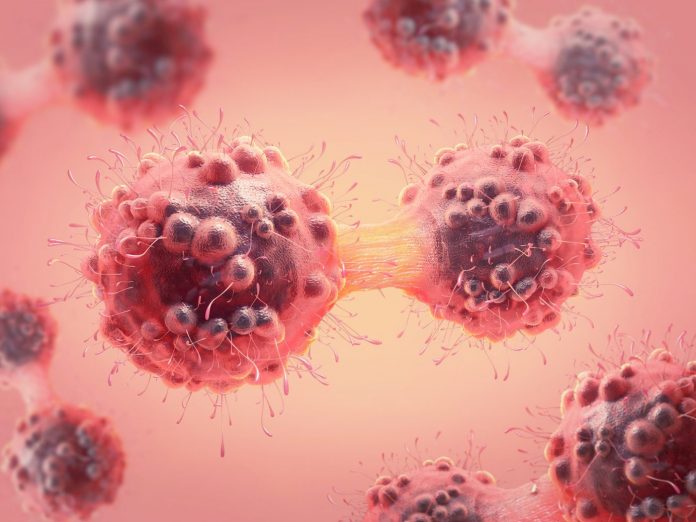
A trio of research papers from Stanford Medicine and collaborators from around the world has detailed how small DNA circles, known as extrachromosomal DNA (ecDNA), are major drivers of certain cancers. The studies, published today in Nature, show the prevalence and prognostic potential of these small DNA circles in nearly 15,000 cancers; highlight a novel method of inheritance that overthrows a fundamental understanding of genetics; and identify a potential new therapy currently in clinical trials that can target the circles.
“The findings we are presenting are part of a completely new understanding of a common and aggressive mechanism that drives cancer,” said study leader Paul Mischel, MD, a professor at Stanford Medicine.
The team, jointly called eDyNAmiC, comprises researchers from around the world, focused on ecDNA—circular DNA fragments that exist outside of the chromosomes in cancer cells. Previously, ecDNA was thought to be a rare and largely inconsequential genetic element. However, Mischel’s lab published research in 2017 challenged this line of thinking by showing that ecDNA is far more widespread and plays an important role in cancer cell survival and proliferation.
“We’re in the midst of a completely new understanding of a common and aggressive mechanism that drives cancer,” said Mischel. “Each paper alone is noteworthy, and taken together they represent a major inflection point in how we view cancer initiation and evolution.”
The first of the three papers, co-authored by Mischel and Howard Chang, MD, PhD, a professor of dermatology and genetics at Stanford, examined the prevalence and clinical implications of ecDNA. Analyzing data from nearly 15,000 cancer patients across 39 tumor types, the team found that that 17.1% of tumors contain ecDNA, that ecDNA was more prevalent after targeted therapy or cytotoxic treatments, and the presence of ecDNA was associated with metastasis and poorer patient outcomes.
The researchers also discovered that some ecDNAs do not directly encode cancer-causing genes, but instead contain enhancer sequences that activate genes on other ecDNAs, linking multiple ecDNA circles.
“This was kind of a heretical idea,” Chang said. “The ecDNAs with enhancer elements don’t confer any benefit to the cell on their own; they have to work with other ecDNAs to spur cancer cell growth. If looked at through a conventional lens, the presence of ecDNAs that solely encode enhancers wouldn’t seem to be a problem. But the teamwork and physical connection between different types of circles is actually very important in cancer development.”
This research provides important new information about which cancer patients are affected, what genes or sequences in DNA are found in ecDNAs, and identified genetic backgrounds and mutational signatures that provide insight into cancer’s origination and growth, Mischel added.
In the second paper, also co-authored by Mischel and Chang, the research team focused on how ecDNA circles are segregated into daughter cells when cancer cells divided. During cell division ecDNAs typically segregate randomly. The result is that some new cells may have many ecDNAs while sister cells had none. This random activity increases the chance that at least some of the population of cells in a tumor will have the right combination of ecDNAs to evade treatments and foster drug resistance.
The investigators said that this is generally the case, but not completely. The research showed that unlike chromosomes, ecDNA transcription continues rampantly during cell division. The result is different ecDNAs working together and remaining interconnected during cell division and segregate together as multi-circle units of daughter cells.
“This upends Gregor Mendel’s rule of independent assortment,” Mischel said. “It’s really stunning and an enormous surprise.”
“Daughter cells that repeatedly inherit particularly advantageous combinations of ecDNA circles should be rare if the segregation of each type of circle is truly random,” Chang continued. “But this study showed that we were seeing many more of these ‘jackpot events’ than would be expected. It’s like getting a good hand in poker. Cancer cells that get dealt that good hand over and over have a huge advantage. Now we understand how this happens.”
The third paper explores a novel therapeutic approach aimed at exploiting a vulnerability in ecDNA-containing cancer cells. The researchers identified a weakness in the cancer cells’ reliance on excessive transcription—the process of copying DNA into RNA. This excessive transcription occurs due to the interconnected nature of ecDNAs, and when the process is disrupted, the cancer cells fail to survive.
The team demonstrated that blocking the checkpoint protein CHK1—an essential regulator of cell division—led to the death of ecDNA-containing tumor cells in the lab and caused regression of tumors in mice. These findings have led to early-phase clinical trials using CHK1 inhibitors in patients with cancers driven by ecDNA.
“This turns the table on these cancer cells,” said Chang. “They are addicted to this excess transcription; they can’t stop themselves. We made this into a vulnerability that results in their death.”
As clinical trials of CHK1 inhibitors progress, the team hopes that their work will lead to new, more effective therapies for patients with cancers involving ecDNA. “We are going to continue exploring the biology of ecDNAs and use that knowledge for the benefit of patients and their families,” Mischel said.





